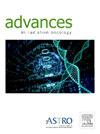给药的全身治疗线的数量对多发性骨髓瘤放射治疗局部反应的影响
IF 2.2
Q3 ONCOLOGY
引用次数: 0
摘要
临床前研究表明,多发性骨髓瘤(MM)倾向于通过多种机制对全身治疗产生耐药性,这些机制也可能诱发放射耐药。本分析的目的是阐明放射治疗(RT)前接受的全身治疗线的数量是否会产生放射耐药并影响局部反应。方法和材料本单中心回顾性研究纳入了2005年1月1日至2023年1月31日期间在我院接受MM放疗的患者。从医疗记录中检索有关RT、全身治疗以及患者和疾病特征的信息。根据RECIST 1.1(实体肿瘤反应评价标准)或PERCIST 1.0(实体肿瘤正电子发射断层扫描反应标准)标准,该分析的主要结果是放疗后6个月的放射学局部反应。次要结果是在RT过程中报告的毒性。结果对366例患者665例MM病变资料进行分析。217例病灶6个月时的局部缓解数据,其中29例完全缓解(13.4%),141例部分缓解(65%),42例病情稳定(19.4%),仅有5例疾病进展(2.3%)。6个月时,既往全身性治疗线的数量对放射学反应没有影响(p = .721)。RT BED10(生物有效剂量)对6个月时的反应有显著影响(p = 0.007)。毒性谱为最佳,等级为>;仅0.9%的病例报告了RT期间的2次事件。结论在这个大型的MM患者回顾性队列中,在RT之前给予的全身治疗线的数量对局部反应没有影响,这与多项临床前研究提出的交叉耐药的担忧相矛盾。RT后的疾病控制是最佳的,治疗期间出现严重毒性的情况是罕见的。本文章由计算机程序翻译,如有差异,请以英文原文为准。
Impact of the Number of Administered Systemic Treatment Lines on Local Response to Radiation Therapy for Multiple Myeloma
Purpose
Multiple myeloma (MM) tends to develop resistance to systemic therapy through multiple mechanisms that might as well induce radioresistance, as suggested by preclinical studies. The aim of the present analysis was to elucidate whether the number of systemic treatment lines received prior to radiation therapy (RT) might confer radioresistance and influence local response.
Methods and Materials
This single-center retrospective study enrolled patients who received RT for MM at our institution between January 1, 2005, and January 31, 2023. Information regarding RT, systemic therapy, and characteristics of the patients and disease were retrieved from medical records. The primary outcome for this analysis was radiologic local response at 6 months after RT, according to RECIST 1.1 (Response Evaluation Criteria in Solid Tumors) or PERCIST 1.0 (Positron Emission Tomography Response Criteria in Solid Tumors) criteria. The secondary outcome was toxicity reported during the RT course.
Results
Data from 665 MM lesions from 366 patients were analyzed. Data regarding local response at 6 months were available for 217 lesions, reporting 29 complete responses (13.4%), 141 partial responses (65%), 42 stable diseases (19.4%), and only 5 disease progressions (2.3%). The number of previous systemic treatment lines had no impact on radiologic response at 6 months (p = .721). RT BED10 (Biologically Effective Dose) had a significant impact on response at 6 months (p = .007). The toxicity profile was optimal, as grade > 2 events during RT were reported only in 0.9% of cases.
Conclusions
In this large retrospective cohort of MM patients, the number of systemic treatment lines administered before RT had no impact on the local response, confuting concerns of cross-resistance raised by multiple preclinical studies. Disease control after RT was optimal, and instances of severe toxicities during treatment were rare.
求助全文
通过发布文献求助,成功后即可免费获取论文全文。
去求助
来源期刊

Advances in Radiation Oncology
Medicine-Radiology, Nuclear Medicine and Imaging
CiteScore
4.60
自引率
4.30%
发文量
208
审稿时长
98 days
期刊介绍:
The purpose of Advances is to provide information for clinicians who use radiation therapy by publishing: Clinical trial reports and reanalyses. Basic science original reports. Manuscripts examining health services research, comparative and cost effectiveness research, and systematic reviews. Case reports documenting unusual problems and solutions. High quality multi and single institutional series, as well as other novel retrospective hypothesis generating series. Timely critical reviews on important topics in radiation oncology, such as side effects. Articles reporting the natural history of disease and patterns of failure, particularly as they relate to treatment volume delineation. Articles on safety and quality in radiation therapy. Essays on clinical experience. Articles on practice transformation in radiation oncology, in particular: Aspects of health policy that may impact the future practice of radiation oncology. How information technology, such as data analytics and systems innovations, will change radiation oncology practice. Articles on imaging as they relate to radiation therapy treatment.
 求助内容:
求助内容: 应助结果提醒方式:
应助结果提醒方式:


